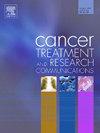化疗引起的恶心和呕吐的风险和替代疗法的临床管理的系统综述
IF 2.4
Q3 Medicine
引用次数: 0
摘要
化疗引起的恶心和呕吐(CINV)影响了高达80% %的癌症患者,严重影响了他们的生活质量和紧张的医疗资源。CINV分为预期型、急性型和延迟型。危险因素包括年轻、女性、CINV病史和化疗药物的致吐潜能。顺铂和蒽环类环磷酰胺联合用药是高度致吐的,风险最大。CINV管理的进展包括循证指南和止吐药物的使用,如5-HT3受体拮抗剂、NK-1受体拮抗剂和皮质类固醇。这些措施减少了呕吐事件,但完全控制恶心仍然具有挑战性。到第四个治疗周期,高达60% %的患者仍然经历延迟性恶心,预期性恶心和呕吐分别影响高达30% %和20% %的患者。临床和替代疗法虽然有效,但研究建议对CINV进行综合管理。由于它对心理和生理都有影响,因此需要量身定制的方法。为了克服这些挑战,指南和止吐方案应根据个别患者的评估和必要的认识进行改进。研究正在开发结合药理学和行为干预的靶向治疗方法,以改善CINV的管理,特别是对目前止吐治疗反应不佳的患者。本文章由计算机程序翻译,如有差异,请以英文原文为准。
A systemic review on chemotherapy induced nausea and vomiting- risk and clinical management with alternative therapies
Chemotherapy-induced nausea and vomiting (CINV) affects up to 80 % of cancer patients, significantly impacts the health in terms of their quality of life and straining healthcare resources. CINV is categorized into anticipatory, acute, and delayed types. Risk factors include younger age, female sex, a history of CINV, and the emetogenic potential of the chemotherapy agents. Drugs like cisplatin and anthracycline-cyclophosphamide combinations are highly emetogenic and pose the greatest risk. Advances in managing CINV include evidence-based guidelines and the use of antiemetic medications such as 5-HT3 receptor antagonists, NK-1 receptor antagonists, and corticosteroids. These measures have reduced vomiting incidents, but complete control of nausea remains challenging. Up to 60 % of patients still experience delayed nausea, and anticipatory nausea and vomiting affect up to 30 % and 20 % of patients, respectively, by the fourth treatment cycle. Clinical and alternative therapies are though effective, research suggests integrated management for CINV. Tailored approach is needed as it has both psychological and physiological influence. To overcome the challenges, the guidelines and antiemetic regimens should be improved according to individual patient evaluation and awareness is necessary. Research is ongoing to develop targeted therapies that combine pharmacological and behavioral interventions to improve CINV management, especially for patients who do not respond well to current antiemetic treatments.
求助全文
通过发布文献求助,成功后即可免费获取论文全文。
去求助
来源期刊

Cancer treatment and research communications
Medicine-Oncology
CiteScore
4.30
自引率
0.00%
发文量
148
审稿时长
56 days
期刊介绍:
Cancer Treatment and Research Communications is an international peer-reviewed publication dedicated to providing comprehensive basic, translational, and clinical oncology research. The journal is devoted to articles on detection, diagnosis, prevention, policy, and treatment of cancer and provides a global forum for the nurturing and development of future generations of oncology scientists. Cancer Treatment and Research Communications publishes comprehensive reviews and original studies describing various aspects of basic through clinical research of all tumor types. The journal also accepts clinical studies in oncology, with an emphasis on prospective early phase clinical trials. Specific areas of interest include basic, translational, and clinical research and mechanistic approaches; cancer biology; molecular carcinogenesis; genetics and genomics; stem cell and developmental biology; immunology; molecular and cellular oncology; systems biology; drug sensitivity and resistance; gene and antisense therapy; pathology, markers, and prognostic indicators; chemoprevention strategies; multimodality therapy; cancer policy; and integration of various approaches. Our mission is to be the premier source of relevant information through promoting excellence in research and facilitating the timely translation of that science to health care and clinical practice.
 求助内容:
求助内容: 应助结果提醒方式:
应助结果提醒方式:


